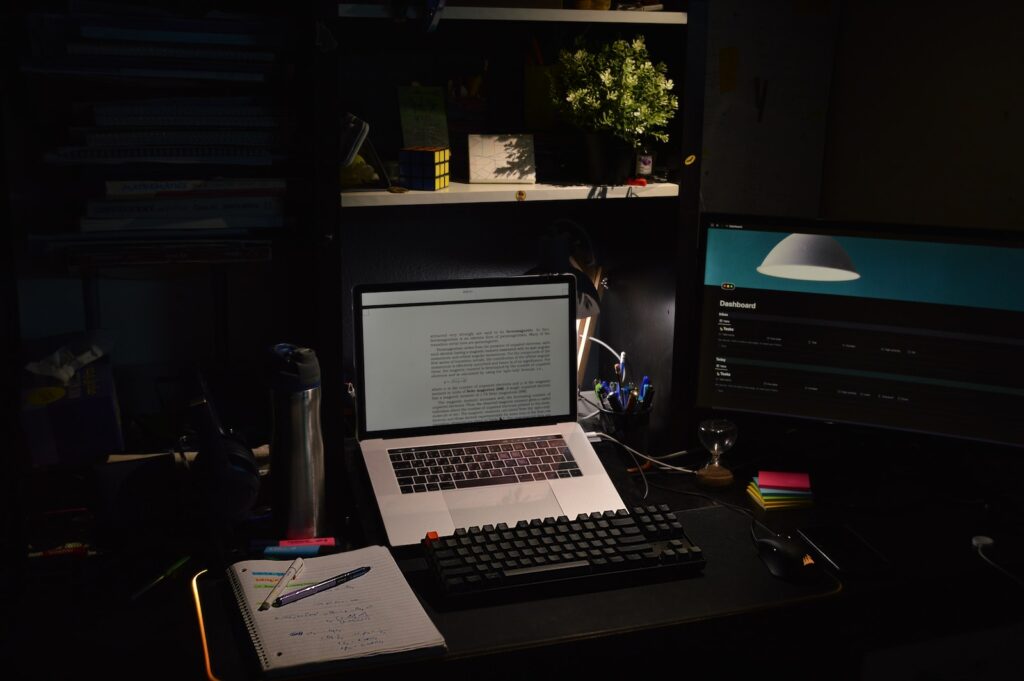Are you tired of bland, boring blog designs? It’s time to step up your game and embrace bold and vibrant color schemes.
Not only do these colors make a statement, but they also add personality and energy to your blog.
When it comes to choosing the perfect color scheme for your blog, there are endless possibilities. From bright pinks and oranges to deep blues and purples, there is no limit to what you can create.
But don’t just choose any random colors – think about what message you want to convey with your brand and select colors that reflect that. Whether you’re looking to stand out from the crowd or simply inject some life into your content, bold and vibrant color schemes are sure to grab attention and leave a lasting impression on your readers.
The Importance Of Color In Blog Design

Picture a world without color – just shades of gray and black. The thought alone is enough to make anyone shudder in dismay. Our lives are so deeply intertwined with hues and tones that it’s hard to imagine living without them.
Color symbolism varies across cultures, but one thing remains constant: colors have the power to evoke emotions and influence our behavior. It’s no wonder then why color plays such an important role in blog design. The right selection of colors can set the tone for your entire website, drawing readers in and keeping them engaged.
From bold and vibrant palettes to muted pastels, there are endless options when it comes to creating a unique look for your blog. But how do you choose which colors will resonate best with your audience? This is where cultural differences come into play.
For example, white symbolizes purity and innocence in Western culture, while it represents mourning in many Eastern countries. Understanding these nuances is crucial in designing a successful blog that speaks directly to your target market.
Choosing The Right Color Palette For Your Brand

Color theory basics are essential to creating a strong brand identity that resonates with your audience. Understanding color psychology is crucial in choosing the right color palette for your blog.
Bold and vibrant color schemes can help you stand out from the competition, but it’s important not to sacrifice cohesiveness and consistency when selecting colors.
Incorporating brand personality into your color choices can also be a powerful tool for building a loyal following. Consider what emotions or feelings you want your brand to evoke in viewers and choose colors accordingly. If you’re running a fitness blog, for example, shades of green might convey health and vitality while bright pinks could represent energy and motivation.
Ultimately, the key to success in picking the right color palette is experimentation. Try different combinations until you find one that feels authentic to your brand and appeals to your target audience. With boldness and creativity, you’ll create an unforgettable visual experience that will keep readers coming back time after time.
Understanding Color Psychology

Did you know that color can affect our mood and behavior? In fact, studies have shown that up to 90% of snap judgments made about products can be based on color alone.
Color symbolism varies across cultures and can impact how we perceive different colors. Understanding the psychology behind color is crucial when it comes to designing a bold and vibrant blog.
To begin with, let’s explore some basic color associations:
- Red – often associated with passion, excitement, and urgency
- Blue – conveys trustworthiness, calmness, and security
- Green – represents growth, balance, and harmony
While these are generalizations, they give us an idea of how certain colors might be perceived by readers depending on their cultural background.
Color symbolism also plays a role in branding. For example, yellow is commonly used in fast food logos because it is believed to stimulate appetite while purple is often used for luxury brands as it symbolizes wealth and extravagance.
By understanding these cultural influences on color perception, bloggers can strategically use certain colors to communicate their brand values effectively.
Incorporating bold and vibrant color schemes into your blog design can make your content stand out from the crowd. However, it’s important to consider the psychological effects of each color before making any decisions.
By doing so, you’ll create a visually appealing blog that not only looks great but resonates with your audience on a deeper level.
Creating Contrast For Maximum Impact

Using bright colors is an excellent way to create a bold and vibrant blog color scheme. Combining neutrals with bright colors is also a great way to create contrast, while contrasting textures can add even more visual interest.
Bold patterns can be used to create a striking look, while color blocking can make a blog stand out. Highlighting elements with a high contrast color scheme can help draw the reader’s attention.
Selecting appropriate shades is essential to creating an aesthetically pleasing blog, and using color gradients can give a modern look.
Using Bright Colors
Are you looking to make a statement with your blog’s color scheme?
Contrasting colors are a great way to create maximum impact and grab readers’ attention. By pairing bold, vibrant hues together, you can establish a visual hierarchy that guides the eye through your content.
One popular technique for using contrasting colors is color blocking. This involves dividing your page into sections of different shades or tones, creating an interesting visual effect that draws the reader in.
Whether you opt for complementary colors like blue and orange or go for something more daring like purple and yellow, the key is to use bright, saturated shades that stand out against each other.
When it comes to incorporating these bold hues into your blog design, there are plenty of options available. From colorful headers and buttons to eye-catching graphics and backgrounds, there are countless ways to infuse your site with personality and energy.
Just be sure to keep things balanced by using white space strategically – this will help prevent your blog from feeling overwhelming or cluttered.
Combining Neutrals
Now that we’ve covered the impact of using contrasting colors in your blog design, let’s shift our focus to another technique: combining neutrals.
While bold hues can be eye-catching and attention-grabbing, neutral accents can add a touch of sophistication and balance to your color scheme.
One way to incorporate neutrals is by pairing them with bright, saturated shades for maximum impact.
For example, you could pair a vibrant yellow header with soft gray text or use white space strategically to create contrast between two different sections on your page.
When using neutrals, it’s important to remember the importance of balancing brightness.
Too much white or gray can make your blog feel dull or uninspired, while too many bold colors can quickly become overwhelming.
By finding the right balance between these two elements, you’ll be able to craft a unique and engaging visual experience for your readers.
So whether you choose to go all-out with bold contrasts or opt for something more understated with neutral accents, there are plenty of ways to infuse personality and energy into your blog design.
With careful consideration of color choices and strategic use of white space, you’ll be well on your way to creating an impactful online presence that resonates with readers.
Contrasting Textures
Now that we’ve explored the importance of using contrasting colors and combining neutrals for maximum impact, let’s delve into another technique: contrasting textures. Texture combinations add depth and interest to your blog design, creating a tactile experience for readers.
One way to incorporate texture is through layering. For instance, you could use a rough-hewn background with sleek typography or pair a smooth image with a textured overlay. The key is finding complementary textures that work together harmoniously without overwhelming the eye.
Texture layering can also be used to create contrast between different sections on your page. By incorporating multiple layers of varying textures in one area while keeping other areas simple, you’re able to guide the reader’s eye towards specific elements on your site.
By carefully considering texture combinations and strategically layering them throughout your blog design, you’ll create an engaging visual experience that captures attention and keeps readers scrolling.
So experiment with different textures until you find the perfect balance for your brand – it just might make all the difference!
Mixing And Matching Colors For Cohesion

Color theory basics are important to keep in mind when mixing and matching colors for a cohesive blog color scheme. Understanding the relationships between primary, secondary, and tertiary colors can help you create harmonious combinations that will stand out to your readers.
Additionally, it’s essential to consider the emotions associated with different hues; warm tones like reds and oranges evoke feelings of excitement and passion while cool blues and greens tend to have calming effects.
When looking for inspiration for your bold and vibrant color scheme, nature is an excellent place to start. The natural world offers an abundance of rich, saturated shades that are sure to catch the eye.
Take cues from sunsets or autumn leaves for warm orange and red hues, or look at ocean waves or greenery for calming blues and greens. By incorporating these natural elements into your palette, you’ll create a visually stunning backdrop that reflects your brand’s personality.
Remember that there are no hard rules when it comes to choosing colors for your blog – ultimately, it’s about creating a unique identity that sets you apart from others in your niche. Don’t be afraid to experiment with unexpected pairings or switch up traditional color schemes altogether.
With some creativity and knowledge of color theory basics, you can craft a captivating online presence that truly shines!
Using Color As A Navigation Tool

Color is an essential aspect of a blog’s design, and it plays an integral role in enhancing the user experience. When used effectively, color can guide users through your website and help them navigate to the information they need quickly.
A well-planned color scheme can also evoke emotions that align with your brand’s messaging, making it a vital component of any branding strategy. To use color as a navigation tool, you must first understand its psychological impact on users.
For instance, warm colors like reds and oranges are known to stimulate excitement and urgency while cooler tones like blues and greens invoke calmness and tranquility. By leveraging this knowledge, you can create intuitive navigational cues for specific sections or pages on your site using appropriate color combinations.
Here are some tips to get you started:
- Use contrasting colors for buttons or call-to-action prompts so that they stand out from other elements on the page.
- Employ consistent color schemes throughout your site to establish a sense of familiarity among users.
- Consider accessibility when choosing colors since certain shades may be difficult for some individuals to see.
- Always keep your brand’s message at the forefront of your mind when selecting hues – ensure that each choice resonates with what you want to communicate to viewers.
When implemented correctly, color can significantly enhance both the look and functionality of your blog. It has the power to make content more accessible by guiding readers towards relevant information while simultaneously reinforcing your brand image.
Remember: The key is not just throwing together random colors but rather creating a thoughtful plan based on how different hues will affect users’ perception of your site.
Best Practices For Implementing Bold And Vibrant Color Schemes

Now that we’ve established how important color can be for navigation, let’s dive into best practices for implementing bold and vibrant color schemes on your blog.
One key strategy is using complementary colors, which are opposite each other on the color wheel. These combinations create a dynamic contrast that draws the eye in and adds energy to your design.
Another way to incorporate bold colors is through utilizing gradients. Gradients allow you to blend multiple hues together seamlessly, creating a smooth transition from one shade to another. This technique can add depth and dimensionality to your site while still maintaining a cohesive look.
When it comes to choosing specific colors for your scheme, consider your brand identity and target audience. Bright pinks or oranges may work well for a youthful fashion blog but not as much for a professional finance site.
Don’t be afraid to experiment with different shades and combinations until you find what works best for you.
By following these tips and incorporating bold and vibrant colors into your blog design, you’re sure to create an eye-catching and memorable experience for your readers.
Remember, there’s no right or wrong when it comes to color – just have fun with it!
Key Takeaways
- Bold and vibrant color schemes can add personality, energy, and make a statement in blog designs.
- Colors have the power to evoke emotions and influence behavior, making color selection crucial in blog design.
- Cultural differences impact color symbolism, so understanding your target market is essential.
- Incorporating brand personality and considering color psychology are important for choosing the right color palette.
- Creating contrast through bright colors, combining neutrals, and contrasting textures can enhance the visual appeal of a blog.
- Color theory basics, such as primary, secondary, and tertiary colors, help in creating harmonious combinations.
- Nature can provide inspiration for bold and vibrant color schemes.
- Color can be used as a navigation tool to guide users and evoke specific emotions.
- Best practices include using complementary colors, gradients, and considering brand identity and target audience.
- Experimentation and creativity are key in creating an eye-catching and memorable blog design.
Useful Table: Color Associations and Psychological Effects
| Color | Associations | Psychological Effects |
|---|---|---|
| Red | Passion, excitement, urgency | Stimulates energy and action |
| Blue | Trustworthiness, calmness | Evokes a sense of stability |
| Green | Growth, balance, harmony | Creates a feeling of freshness |
| Yellow | Stimulates appetite | Increases attention and focus |
| Purple | Wealth, extravagance | Represents luxury and royalty |
| Orange | Energy, motivation | Inspires enthusiasm and creativity |
| Pink | Youthfulness | Elicits a sense of playfulness |
| Gray | Neutrality, sophistication | Provides a balanced backdrop |
| White | Purity, innocence | Creates a sense of simplicity |
| Black | Elegance, authority | Conveys power and formality |
Frequently Asked Questions
Why are bold and vibrant color schemes important for blogs?
Bold and vibrant color schemes make a statement and add personality and energy to your blog. They help your blog stand out and leave a lasting impression on readers.
How do colors affect our emotions and behavior?
Colors have the power to evoke emotions and influence our behavior. Different colors symbolize different things in different cultures. Understanding color psychology is crucial in designing a successful blog that resonates with your target market.
How do I choose the right color palette for my brand?
Consider the message you want to convey with your brand and select colors that reflect that. Think about the emotions or feelings you want your brand to evoke in viewers. Experiment with different color combinations until you find one that feels authentic to your brand and appeals to your target audience.
How can I create contrast and visual interest in my blog design?
You can create contrast by using bright, saturated colors in combination with neutrals. Color blocking, highlighting elements with high contrast colors, and using contrasting textures can also add visual interest to your blog design.
What are some best practices for implementing bold and vibrant color schemes?
Use complementary colors and gradients to create dynamic contrast and depth in your design. Consider your brand identity and target audience when choosing specific colors. Experiment with different shades and combinations to find what works best for you. Remember to have fun with colors and create a visually appealing experience for your readers.
Final Thoughts
In conclusion, implementing bold and vibrant color schemes for your blog can make a world of difference in attracting and retaining readers. But it’s not just about choosing random colors that look pretty together. It’s important to understand the psychology behind each color and how they work together to create contrast and cohesion.
By using colors as a navigation tool, you can guide your audience through your content with ease while also adding personality and flair to your brand.
Remember, there is no one-size-fits-all approach when it comes to color palettes, so experiment with different combinations until you find what works best for you.
As the saying goes, ‘a picture is worth a thousand words,’ but in this case, a well-executed color scheme may be worth even more!

